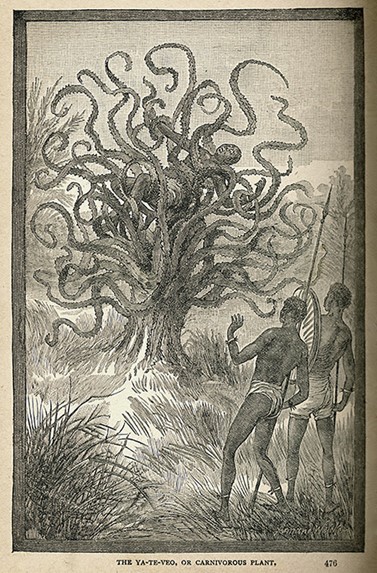
Credit: James W. Buel, public domain, via Wikimedia Commons
Background
Synopsis: In nutrient-poor landscapes where survival is a struggle, some plants have evolved into silent hunters—trapping and digesting unsuspecting prey. From the snap of a Venus flytrap to the slippery depths of a pitcher plant, and even the bizarre “toilet plants” that feast on animal waste, these botanical carnivores reveal the strange and cunning ways nature adapts to harsh environments.
- Imagine a fly buzzing through the thick, humid air of a shadowy bog on a hot summer day. It drifts from one leaf to the next, pausing for just a moment—until the plant beneath it moves. In a blink—snap! The fly is trapped, its fate sealed by the swift jaws of a Venus flytrap.
- But why would a plant need to hunt at all? Plants are supposed to draw nutrients from the soil, not snare their food like predators. Yet the Venus flytrap, along with nearly 750 other species of carnivorous plants, have evolved a taste for flesh—an extraordinary adaptation to survive in nutrient-poor environments.
- Like every living thing, plants need certain nutrients to survive. These include carbon, nitrogen, phosphorus, oxygen and potassium.
- They get carbon and oxygen through photosynthesis when absorbing carbon dioxide through their leaf pores, or stomata. All the other essential nutrients are obtained through their roots.
- But what if the soil is too poor to provide the basic nutrients the plant needs? Most plants wouldn’t survive—but some have found another way.
- Carnivorous plants are often found in bogs, swamps and forests, locations where the soil is acidic and waterlogged, and nitrogen and phosphorus are scarce.
- Like mythical vampires thirsting for blood to survive, these plants turned to a shocking alternative—eating living creatures.
- Over millions of years, certain plants developed deadly adaptations, a feat evolutionary biologists believe evolved at least five separate times. In the 140 million years that flowering plants have been in existence, they have repeatedly developed the ability to adapt to harsh living conditions and eat insects to survive.
- Genetic studies show that enzymes originally used for disease resistance were repurposed into digestive enzymes over time. This allowed plants to consume, digest and absorb needed nutrients from the meat of insects.
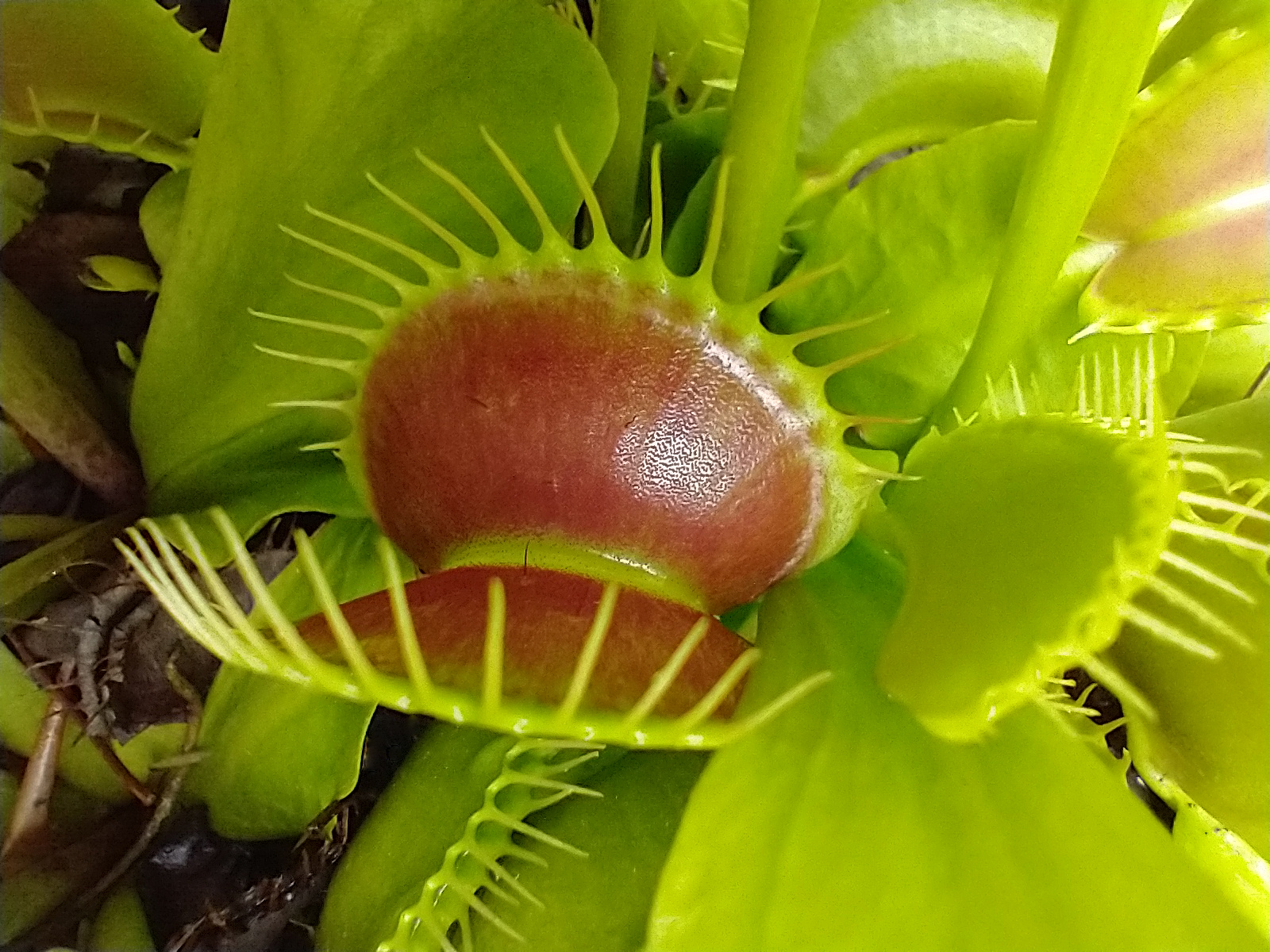
Many plant lovers have a fascination for carnivorous plants like this cultivated variety of Venus flytrap (Dionaea muscipula). Maybe it’s easier to take care of these plants than swat flies!
Credit: Philipdotcom, CC BY-SA 4.0, via Wikimedia Commons
- These killers come in many forms.
- The Venus flytrap developed spring-loaded jaws. When an insect lands inside, the plant patiently waits before snapping shut—like a calculating predator that knows when to strike.
- The snapping mechanism is triggered by mechanoreceptors on its inner lobes. A single touch does nothing, but if two hairs are touched within 20 seconds, an electrical signal is sent, causing the trap to close.
- The enchanting sundew glistens with droplets of what looks like sweet nectar but is, in fact, a “false nectar.” An insect lands, only to realize it’s stuck; tentacles reach out and wrap around the doomed insect within minutes.
- Sundews and butterworts secrete mucilage from the tentacles, trap its meal, and then absorb nutrients from the tentacle tips.
- The tentacles return to their original positions after the prey has been consumed and all the available nutrients have been absorbed.
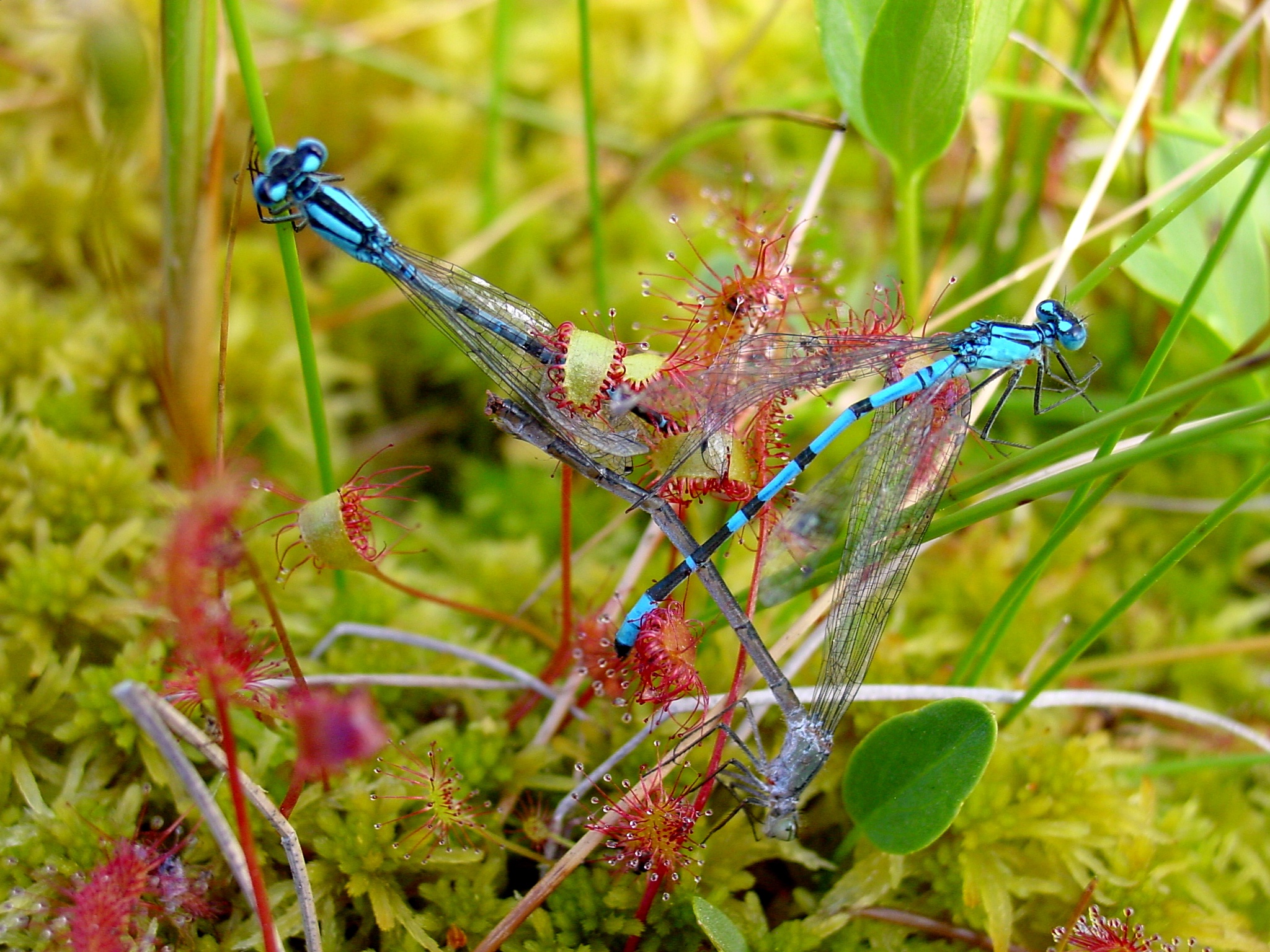
The glistening, sticky tentacles of a sundew (Drosera anglica) attract, capture and digest insect prey. This amazing photo shows three damselflies (Enallagma cyathigerum) ensnarled by the enticing plant.
Credit: Noah Elhardt, CC BY-SA 2.5, via Wikimedia Commons
- The seductive pitcher plant lures victims with its scent. Once inside, the walls are too slippery for the insect to climb, and the only way to go is down—into a pool of digestive fluids.
- These digestive enzymes are like those in the stomachs of animals—breaking down proteins, fats, and even chitin, the natural plastic that makes up an insect’s exoskeleton.
- An Indonesian species of pitcher plant (Nepenthes pudica) was discovered to grow under layers of moss or in the sunken cavities of trees, capturing larger ants, beetles and other subterranean insects.
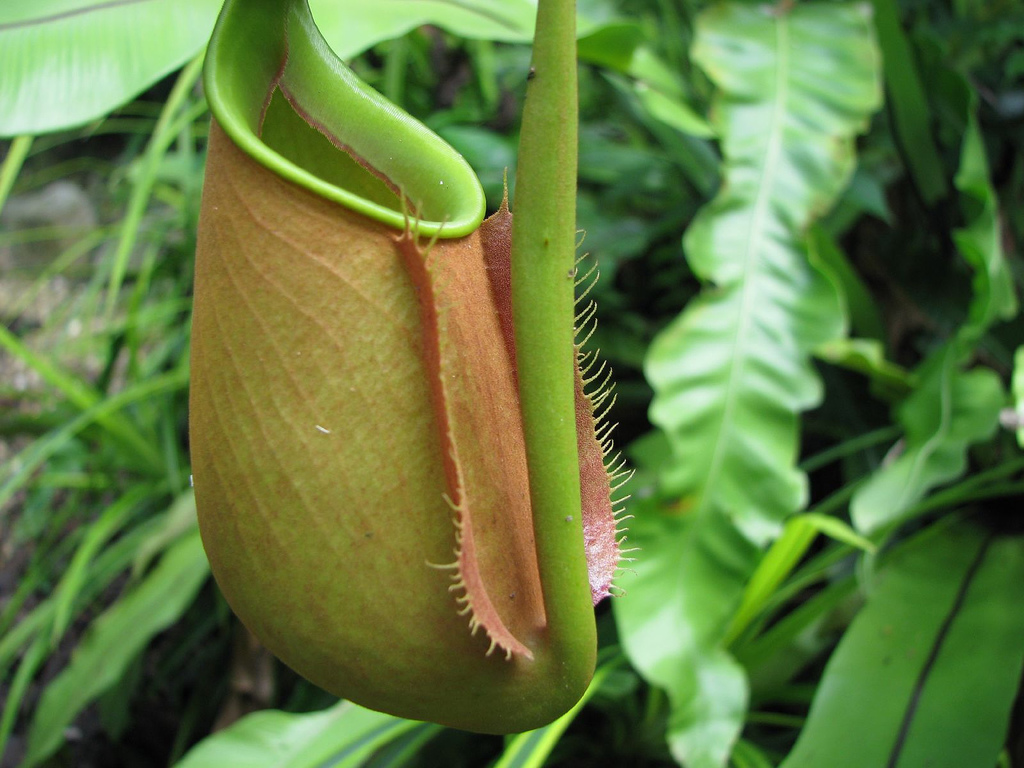
his Malaysian species of pitcher plant is known locally as “monkey cup.” Pitchers grow along the long, twining vines in the tropical rainforest. Once an insect falls into the cup, it is nearly impossible to escape.
Credit: Richard W Sinyem, CC BY 2.0, via Wikimedia Commons
- The Venus flytrap developed spring-loaded jaws. When an insect lands inside, the plant patiently waits before snapping shut—like a calculating predator that knows when to strike.
- Just when you think plants eating insects is strange enough, some plants have found an even grosser way to survive.
- Recently discovered on the island of Borneo, a small group of pitcher plants may have taken evolution in a wild new direction, developing into “toilet plants.”
- As a small mammal scurries through undergrowth on a forest floor, the large cup-shaped pitcher plant attracts the animal, luring it with a sugary nectar. While the animal feeds on the sweet treat, if the plant is lucky, the animal defecates directly into the pitcher’s tubes.
- Instead of catching bugs and having to go through all the work of digestion, these toilet plants are absorbing nutrients in an ingenious and highly efficient manner.
- Researchers found that nitrogen levels in these pitcher plants were significantly higher when they absorbed animal waste compared to digesting insects.
- DNA studies suggest that Nepenthes rajah and Nepenthes lowii have actually lost some of their insect-attracting traits while developing structures that are more suited for larger animals.
- The plants even adapted their nectar composition to attract tree shrews and bats rather than insects.
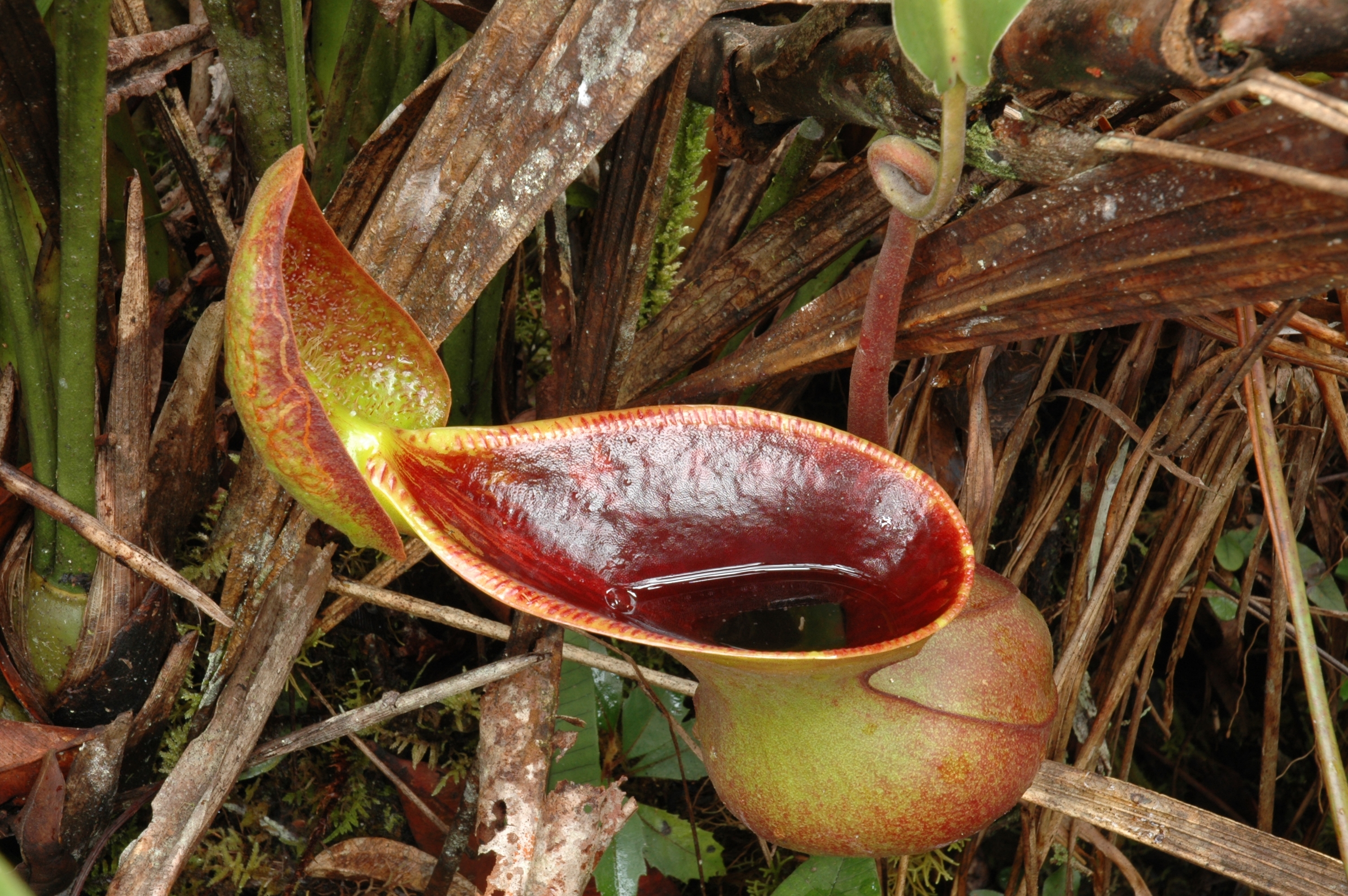
A few species of pitcher plant have adapted to be able to absorb waste from small animals. This species, Nepenthes lowii, looks like a perfect toilet seat for a small bat!
Credit: JeremiahsCPs CC BY-SA 3.0, Wikimedia Commons
- Scary mythical villains like Frankenstein’s monster and King Kong are often feared because they are misunderstood. Scary, and very real, carnivorous plants aren’t villains either—they are survivors, transformed by their harsh environments.
- Carnivorous plants have managed to thrive in very specific conditions and can’t survive outside their natural habitat, making them exceptionally vulnerable to environmental changes.
- Some species, like cobra lily (Darlingtonia californica), rely on unique microbial communities in their pitchers to break down prey, adding another layer of ecological complexity.
- Many of these plants are endangered, threatened by habitat destruction and illegal collection.
- These plants aren’t just curiosities—they help control insect populations and support ecosystems.
- Today there are carnivorous species found on every continent except Antarctica. Carnivorous plants may seem unusual, but they’re simply responding to the challenges of their environment in remarkable ways. Whether trapping insects or absorbing nutrients from animal waste, they remind us that nature constantly finds creative solutions for survival.
Episode script
True to its name, the Venus Flytrap looks like it came from another planet, and it eats bugs.
It may seem alien, but carnivorous plants are surprisingly common. There are 750 species, living on every continent but Antarctica.
They exist wherever the soil can’t provide all the nutrients that plants need. So they look to other sources—often insects.
The Venus Flytrap is the most well-known. Its “jaws” stand open until an unsuspecting fly touches hairs within for several seconds. That triggers an electrical impulse and the jaws snap shut. Then enzymes slowly digest the prey.
The Sundew has tentacles with glistening drops on the ends that look like nectar. But insects that land to partake find they’re actually sticky digestive fluid. The Sundew’s tentacles wrap around the bug and feast.
The Pitcher Plant looks like its namesake, with a smell that attracts insects. But if they crawl inside, the walls are too slippery to escape.
Waiting at the bottom: more digestive enzymes that will melt them alive.
And if that’s not gross enough… the ‘toilet plant’ looks like its namesake. It produces a sweet nectar to lure rodents or bats.
When they come to drink, extended beneath them is a bowl to catch whatever they excrete. The plant gets all its nitrogen and other minerals from animal droppings.
So, if you think eating bugs is unappetizing, well, it could be worse.

